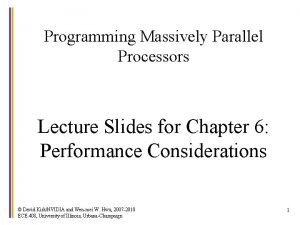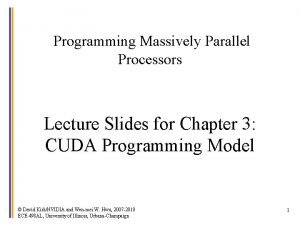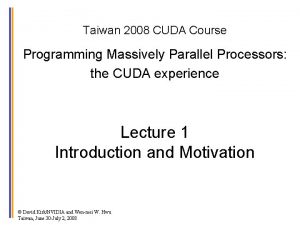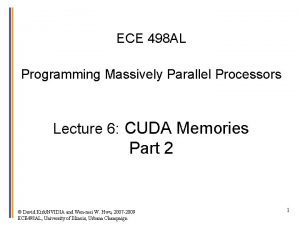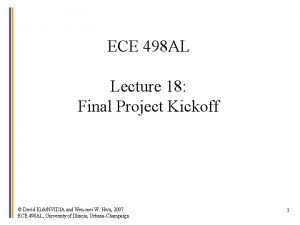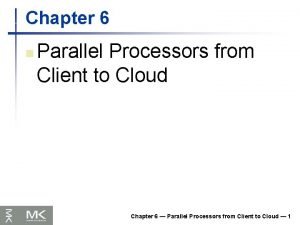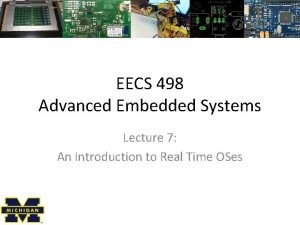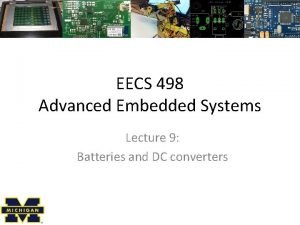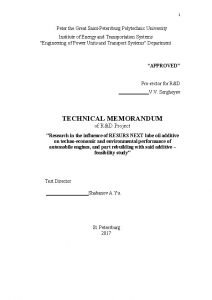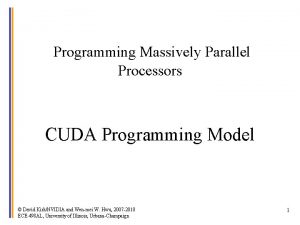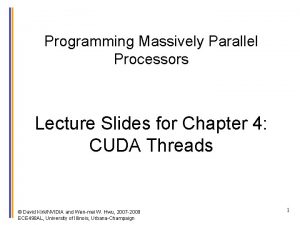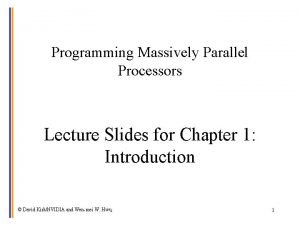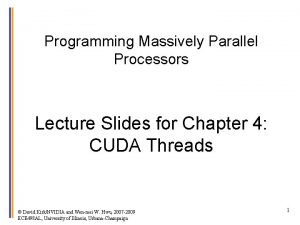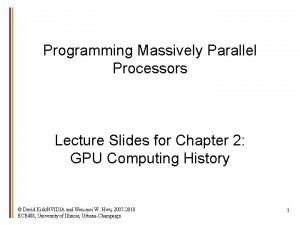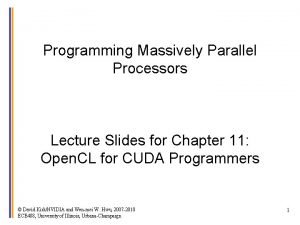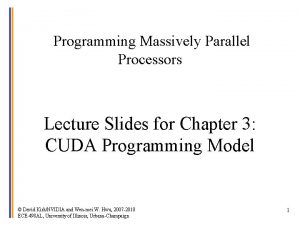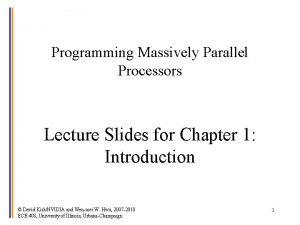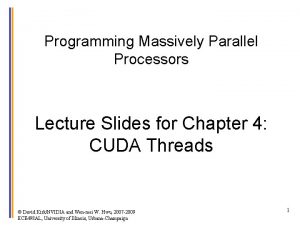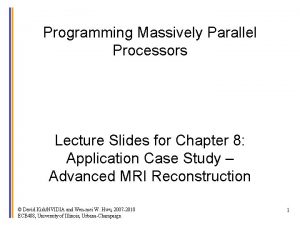ECE 498 AL Programming Massively Parallel Processors Lecture














- Slides: 14

ECE 498 AL Programming Massively Parallel Processors Lecture 6: CUDA Memories Part 2 © David Kirk/NVIDIA and Wen-mei W. Hwu, 2007 -2009 ECE 498 AL, University of Illinois, Urbana Champaign 1

bx Tiled Multiply Md 1 2 tx TILE_WIDTH Nd WIDTH 0 1 2 TILE_WIDTH-1 TILE_WIDTH • Break up the execution of the kernel into phases so that the data accesses in each phase is focused on one subset (tile) of Md and Nd 0 Pd 1 ty Pdsub TILE_WIDTH-1 TILE_WIDTH 2 © David Kirk/NVIDIA and Wen-mei W. Hwu, 2007 -2009 ECE 498 AL, University of Illinois, Urbana Champaign WIDTH by 0 1 2 TILE_WIDTHE 0 TILE_WIDTH 2

A Small Example Nd 0, 0 Nd 1, 0 Nd 0, 1 Nd 1, 1 Nd 0, 2 Nd 1, 2 Nd 0, 3 Nd 1, 3 Md 0, 0 Md 1, 0 Md 2, 0 Md 3, 0 Pd 0, 0 Pd 1, 0 Pd 2, 0 Pd 3, 0 Md 0, 1 Md 1, 1 Md 2, 1 Md 3, 1 Pd 0, 1 Pd 1, 1 Pd 2, 1 Pd 3, 1 Pd 0, 2 Pd 1, 2 Pd 2, 2 Pd 3, 2 Pd 0, 3 Pd 1, 3 Pd 2, 3 Pd 3, 3 © David Kirk/NVIDIA and Wen-mei W. Hwu, 2007 -2009 ECE 498 AL, University of Illinois, Urbana Champaign 3

Every Md and Nd Element is used exactly twice in generating a 2 X 2 tile of P P 0, 0 thread 0, 0 Access order P 1, 0 thread 1, 0 P 0, 1 thread 0, 1 P 1, 1 thread 1, 1 M 0, 0 * N 0, 0 M 0, 0 * N 1, 0 M 0, 1 * N 0, 0 M 0, 1 * N 1, 0 M 1, 0 * N 0, 1 M 1, 0 * N 1, 1 M 1, 1 * N 0, 1 M 1, 1 * N 1, 1 M 2, 0 * N 0, 2 M 2, 0 * N 1, 2 M 2, 1 * N 0, 2 M 2, 1 * N 1, 2 M 3, 0 * N 0, 3 M 3, 0 * N 1, 3 M 3, 1 * N 0, 3 M 3, 1 * N 1, 3 © David Kirk/NVIDIA and Wen-mei W. Hwu, 2007 -2009 ECE 498 AL, University of Illinois, Urbana Champaign 4

Breaking Md and Nd into Tiles • Break up the inner product loop of each thread into phases • At the beginning of each phase, load the Md and Nd elements that everyone needs during the phase into shared Md 0, 0 Md 1, 0 Md 2, 0 Md 3, 0 memory Md 0, 1 Md 1, 1 Md 2, 1 Md 3, 1 • Everyone access the Md and Nd elements from the shared memory during the phase © David Kirk/NVIDIA and Wen-mei W. Hwu, 2007 -2009 ECE 498 AL, University of Illinois, Urbana Champaign Nd 0, 0 Nd 1, 0 Nd 0, 1 Nd 1, 1 Nd 0, 2 Nd 1, 2 Nd 0, 3 Nd 1, 3 Pd 0, 0 Pd 1, 0 Pd 2, 0 Pd 3, 0 Pd 0, 1 Pd 1, 1 Pd 2, 1 Pd 3, 1 Pd 0, 2 Pd 1, 2 Pd 2, 2 Pd 3, 2 Pd 0, 3 Pd 1, 3 Pd 2, 3 Pd 3, 3 5

Each phase of a Thread Block uses one tile from Md and one from Nd Step 4 Phase 1 Step 52 Step 6 Phase T 0, 0 Md 0, 0 Nd 0, 0 ↓ Mds 0, 0 ↓ Nds 0, 0 PValue 0, 0 += Mds 0, 0*Nds 0, 0 + Mds 1, 0*Nds 0, 1 Md 2, 0 ↓ Mds 0, 0 Nd 0, 2 ↓ Nds 0, 0 PValue 0, 0 += Mds 0, 0*Nds 0, 0 + Mds 1, 0*Nds 0, 1 T 1, 0 Md 1, 0 Nd 1, 0 ↓ Mds 1, 0 ↓ Nds 1, 0 PValue 1, 0 += Mds 0, 0*Nds 1, 0 + Mds 1, 0*Nds 1, 1 Md 3, 0 ↓ Mds 1, 0 Nd 1, 2 ↓ Nds 1, 0 PValue 1, 0 += Mds 0, 0*Nds 1, 0 + Mds 1, 0*Nds 1, 1 T 0, 1 Md 0, 1 Nd 0, 1 ↓ Mds 0, 1 ↓ Nds 0, 1 Pd. Value 0, 1 += Mds 0, 1*Nds 0, 0 + Mds 1, 1*Nds 0, 1 Md 2, 1 ↓ Mds 0, 1 Nd 0, 3 ↓ Nds 0, 1 Pd. Value 0, 1 += Mds 0, 1*Nds 0, 0 + Mds 1, 1*Nds 0, 1 T 1, 1 Md 1, 1 Nd 1, 1 ↓ Mds 1, 1 ↓ Nds 1, 1 Pd. Value 1, 1 += Mds 0, 1*Nds 1, 0 + Mds 1, 1*Nds 1, 1 Md 3, 1 ↓ Mds 1, 1 Nd 1, 3 ↓ Nds 1, 1 Pd. Value 1, 1 += Mds 0, 1*Nds 1, 0 + Mds 1, 1*Nds 1, 1 time © David Kirk/NVIDIA and Wen-mei W. Hwu, 2007 -2009 ECE 498 AL, University of Illinois, Urbana Champaign 6

Tiled Matrix Multiplication Kernel __global__ void Matrix. Mul. Kernel(float* Md, float* Nd, float* Pd, int Width) { 1. 2. __shared__float Mds[TILE_WIDTH]; __shared__float Nds[TILE_WIDTH]; 3. 4. int bx = block. Idx. x; int by = block. Idx. y; int tx = thread. Idx. x; int ty = thread. Idx. y; // Identify the row and column of the Pd element to work on 5. int Row = by * TILE_WIDTH + ty; 6. int Col = bx * TILE_WIDTH + tx; 7. float Pvalue = 0; // Loop over the Md and Nd tiles required to compute the Pd element 8. for (int m = 0; m < Width/TILE_WIDTH; ++m) { // Coolaborative loading of Md and Nd tiles into shared memory 9. Mds[ty][tx] = Md[Row*Width + (m*TILE_WIDTH + tx)]; 10. Nds[ty][tx] = Nd[Col + (m*TILE_WIDTH + ty)*Width]; 11. __syncthreads(); 11. 12. 13. 14. 13. } for (int k = 0; k < TILE_WIDTH; ++k) Pvalue += Mds[ty][k] * Nds[k][tx]; Synchthreads(); } Pd[Row*Width+Col] = Pvalue; © David Kirk/NVIDIA and Wen-mei W. Hwu, 2007 -2009 ECE 498 AL, University of Illinois, Urbana Champaign 7

CUDA Code – Kernel Execution Configuration // Setup the execution configuration dim 3 dim. Block(TILE_WIDTH, TILE_WIDTH); dim 3 dim. Grid(Width / TILE_WIDTH, Width / TILE_WIDTH); © David Kirk/NVIDIA and Wen-mei W. Hwu, 2007 -2009 ECE 498 AL, University of Illinois, Urbana Champaign 8

First-order Size Considerations in G 80 • Each thread block should have many threads – TILE_WIDTH of 16 gives 16*16 = 256 threads • There should be many thread blocks – A 1024*1024 Pd gives 64*64 = 4096 Thread Blocks – TILE_WIDTH of 16 gives each SM 3 blocks, 768 threads (full capacity) • Each thread block perform 2*256 = 512 float loads from global memory for 256 * (2*16) = 8, 192 mul/add operations. – Memory bandwidth no longer a limiting factor © David Kirk/NVIDIA and Wen-mei W. Hwu, 2007 -2009 ECE 498 AL, University of Illinois, Urbana Champaign 9

bx Tiled Multiply m bx by 1 ty 0 1 2 k Pd by Pdsub k TILE_WIDTH-1 TILE_WIDTH 2 © David Kirk/NVIDIA and Wen-mei W. Hwu, 2007 -2009 ECE 498 AL, University of Illinois, Urbana Champaign WIDTH m 0 TILE_WIDTH Nd WIDTH 0 1 2 TILE_WIDTH-1 TILE_WIDTHE Md 2 tx TILE_WIDTH • Each thread computes one element of Pdsub 1 TILE_WIDTH • Each block computes one square sub-matrix Pdsub of size 0 TILE_WIDTH 10

G 80 Shared Memory and Threading • Each SM in G 80 has 16 KB shared memory – SM size is implementation dependent! – For TILE_WIDTH = 16, each thread block uses 2*256*4 B = 2 KB of shared memory. – The shared memory can potentially have up to 8 Thread Blocks actively executing • This allows up to 8*512 = 4, 096 pending loads. (2 per thread, 256 threads per block) • The threading model limits the number of thread blocks to 3 so shared memory is not the limiting factor here – The next TILE_WIDTH 32 would lead to 2*32*32*4 B= 8 KB shared memory usage per thread block, allowing only up to two thread blocks active at the same time • Using 16 x 16 tiling, we reduce the accesses to the global memory by a factor of 16 – The 86. 4 B/s bandwidth can now support (86. 4/4)*16 = 347. 6 GFLOPS! © David Kirk/NVIDIA and Wen-mei W. Hwu, 2007 -2009 ECE 498 AL, University of Illinois, Urbana Champaign 11

Tiled Matrix Multiplication Kernel __global__ void Matrix. Mul. Kernel(float* Md, float* Nd, float* Pd, int Width) { 1. 2. __shared__float Mds[TILE_WIDTH]; __shared__float Nds[TILE_WIDTH]; 3. 4. int bx = block. Idx. x; int by = block. Idx. y; int tx = thread. Idx. x; int ty = thread. Idx. y; // Identify the row and column of the Pd element to work on 5. int Row = by * TILE_WIDTH + ty; 6. int Col = bx * TILE_WIDTH + tx; 7. float Pvalue = 0; // Loop over the Md and Nd tiles required to compute the Pd element 8. for (int m = 0; m < Width/TILE_WIDTH; ++m) { // Coolaborative loading of Md and Nd tiles into shared memory 9. Mds[ty][tx] = Md[Row*Width + (m*TILE_WIDTH + tx)]; 10. Nds[ty][tx] = Nd[Col + (m*TILE_WIDTH + ty)*Width]; 11. __syncthreads(); 11. 12. 13. 14. 13. } for (int k = 0; k < TILE_WIDTH; ++k) Pvalue += Mds[ty][k] * Nds[k][tx]; Synchthreads(); } Pd[Row*Width+Col] = Pvalue; © David Kirk/NVIDIA and Wen-mei W. Hwu, 2007 -2009 ECE 498 AL, University of Illinois, Urbana Champaign 12

Tiling Size Effects © David Kirk/NVIDIA and Wen-mei W. Hwu, 2007 -2009 ECE 498 AL, University of Illinois, Urbana Champaign 13

Summary- Typical Structure of a CUDA Program • • • Global variables declaration – __host__ – __device__. . . __global__, __constant__, __texture__ Function prototypes – __global__ void kernel. One(…) – float handy. Function(…) Main () – allocate memory space on the device – cuda. Malloc(&d_Glbl. Var. Ptr, bytes ) – transfer data from host to device – cuda. Mem. Cpy(d_Glbl. Var. Ptr, h_Gl…) – execution configuration setup – kernel call – kernel. One<<<execution configuration>>>( args… ); – transfer results from device to host – cuda. Mem. Cpy(h_Glbl. Var. Ptr, …) – optional: compare against golden (host computed) solution Kernel – void kernel. One(type args, …) – variables declaration - __local__, __shared__ • automatic variables transparently assigned to registers or local memory – syncthreads()… Other functions – float handy. Function(int in. Var…); © David Kirk/NVIDIA and Wen-mei W. Hwu, 2007 -2009 ECE 498 AL, University of Illinois, Urbana Champaign repeat as needed 14
 Programming massively parallel processors
Programming massively parallel processors Programming massively parallel processors
Programming massively parallel processors Programming massively parallel processors
Programming massively parallel processors Programming massively parallel processors, kirk et al.
Programming massively parallel processors, kirk et al. Ece 498
Ece 498 Ece 498
Ece 498 Parallel processors from client to cloud
Parallel processors from client to cloud 01:640:244 lecture notes - lecture 15: plat, idah, farad
01:640:244 lecture notes - lecture 15: plat, idah, farad Cs 498 vr
Cs 498 vr Eecs 498
Eecs 498 Cs498 dl
Cs498 dl Eecs 498
Eecs 498 Quem pode o mais pode o menos
Quem pode o mais pode o menos Cs 498 vr
Cs 498 vr +1 (432) 498-0251
+1 (432) 498-0251

